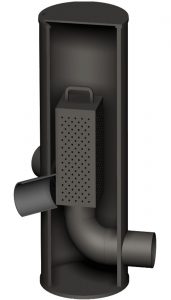In today's world, where sustainable living is gaining prominence, finding innovative ways to conserve water and create an eco-friendly environment is crucial. This article explores the concept of rainwater harvesting, the benefits it offers, and how it can be integrated with large terracotta plant pots and large rectangular planters to enhance your gardening experience while promoting sustainability.
2. Understanding Rainwater Harvesting
Rainwater harvesting is the process of collecting and storing rainwater for later use. It involves capturing rainwater from rooftops, surfaces, or any other catchment area and channeling it into storage tanks or containers. This harvested rainwater can be utilized for various purposes such as irrigation, gardening, and even household needs.
3. Benefits of Rainwater Harvesting
Rainwater harvesting offers numerous benefits, both for the environment and the individual. Some of the key advantages include:
Water Conservation: By harvesting rainwater, you reduce your reliance on freshwater sources, helping to conserve this precious resource.
Cost Savings: Utilizing rainwater for gardening eliminates the need for tap water, resulting in reduced water bills.
Environmental Impact: Rainwater harvesting reduces the strain on local water supplies and minimizes the risk of water scarcity during drought periods.
Plant Health: Rainwater is naturally soft and free from chemicals, making it ideal for plants as it provides essential nutrients without any adverse effects.
Stormwater Management: Harvesting rainwater reduces stormwater runoff, which can help prevent soil erosion and flooding in urban areas.
4. Large Terracotta Plant Pots: A Gardener's Delight
Large terracotta plant pots have long been favored by gardeners for their rustic charm and functional benefits. These pots are made from natural clay, offering excellent breathability and insulation for plants' root systems. The porous nature of terracotta allows air and moisture to pass through the walls, promoting healthier plant growth. Additionally, their large size provides ample space for root development, ensuring robust and thriving plants.
5. The Advantages of Large Rectangular Planters
Large rectangular planters have gained popularity among garden enthusiasts due to their versatility and aesthetic appeal. These planters offer a contemporary touch to outdoor spaces, making them a perfect choice for modern gardens. The elongated shape of rectangular planters allows for the cultivation of a wide range of plants, including flowers, herbs, vegetables, and even small trees. Their generous size accommodates multiple plants, creating stunning displays and adding visual interest to any garden.
6. Combining Rainwater Harvesting with Large Terracotta Plant Pots and Large Rectangular Planters
By combining rainwater harvesting with large terracotta plant pots and large rectangular planters, you can create an eco-friendly garden that thrives sustainably. Here's how:
Rainwater as a Natural Irrigation Source: Utilize harvested rainwater to irrigate your garden, reducing the need for tap water. The porous terracotta pots and planters will absorb and distribute water effectively, ensuring plants receive adequate moisture.
Water Conservation and Sustainable Gardening: Rainwater harvesting promotes water conservation, while the use of terracotta pots and planters encourages healthy plant growth. Together, they contribute to sustainable gardening practices that minimize water waste and maximize the health of your garden.
7. Step-by-Step Guide to Setting Up a Rainwater Harvesting System
Setting up a rainwater harvesting system is relatively simple. Follow these steps to get started:
Install gutters and downspouts to direct rainwater from your roof into storage containers.
Place a debris filter or mesh at the entry point of your rainwater collection system to prevent leaves and debris from entering.
Connect the downspouts to a rainwater storage tank or barrels.
Install an overflow mechanism to divert excess water away from your home's foundation.
Use a pump or gravity to distribute the harvested rainwater to your garden and containers.
8. Choosing the Right Large Terracotta Plant Pots for Your Garden
When selecting large terracotta plant pots, consider the following factors:
Size and Shape: Choose pots that are large enough to accommodate the root system of your plants. Opt for a shape that complements the aesthetics of your garden.
Quality: Look for high-quality terracotta pots that are well-fired and durable. Ensure they have proper drainage holes to prevent waterlogging.
Maintenance: Consider the maintenance requirements of terracotta pots, such as occasional cleaning and protection from extreme weather conditions.
9. Enhancing Your Garden with Large Rectangular Planters
To make the most of large rectangular planters, follow these tips:
Plant Selection: Choose plants that thrive in containers and suit the dimensions of the planter.
Arrangement: Arrange plants in a visually appealing manner, considering their height, color, and growth habits.
Drainage: Ensure proper drainage by adding a layer of gravel or broken pottery at the bottom of the planter.
Maintenance: Regularly water and fertilize plants, and trim them as necessary to maintain their shape and appearance.
10. Maintenance Tips for Rainwater Harvesting System and Garden Containers
To keep your rainwater harvesting system and garden containers in optimal condition, follow these maintenance tips:
Rainwater Harvesting System: Clean gutters and downspouts regularly to prevent blockages. Inspect storage containers for leaks or damage. Flush the system periodically to remove sediment or debris.
Terracotta Plant Pots: Clean terracotta pots to remove mineral deposits or algae. Protect them from freezing temperatures by moving them indoors or providing insulation.
Rectangular Planters: Check for adequate drainage and clear any blockages. Regularly prune and fertilize plants in the planters.
Incorporating a rainwater harvesting system, large terracotta plant pots, and large rectangular planters into your gardening practices is an excellent way to promote sustainability and create a beautiful outdoor space. By harnessing the power of rainwater, utilizing porous terracotta containers, and optimizing space with rectangular planters, you can achieve a thriving garden while conserving water resources. Embrace these eco-friendly practices and watch your garden flourish!
.jpg)


